Demolished arch led to creation of new St Leonards seafront boundary
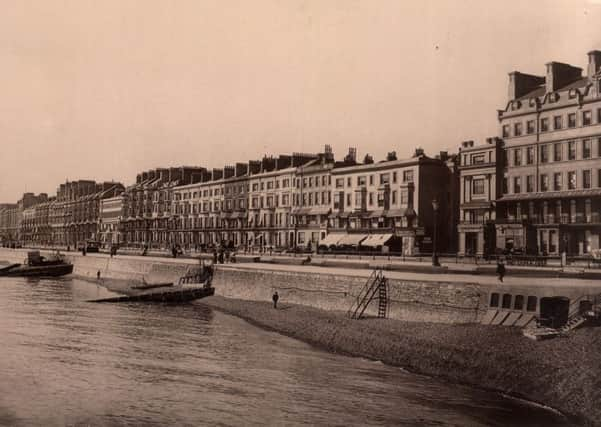

This situation came about because St. Leonards on sea didn’t come into existence until 1828 when London architect James Burton founded the new town on part of Gensing Farm purchased from the Eversfield Estate and he marked his eastern boundary with an arch across the seafront road just west of the bottom of London Road where today a red granite obelisk marks its site.
The original boundary arch was demolished overnight in January 1895 by Hastings Corporation.
Advertisement
Hide AdAdvertisement
Hide AdThe Post Office had other ideas about boundaries, based on the location of their sorting offices, and decided that operationally the boundary would run north from Hastings Pier firmly placing Eversfield Place and Warrior Square in St Leonards and post would be considerably delayed if the wrong postal town was used in the address.
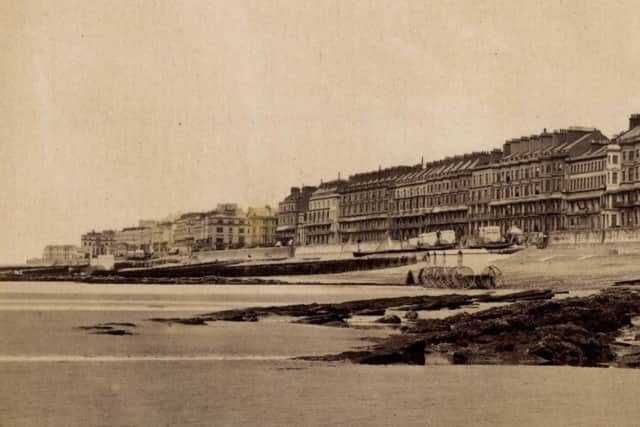

Work had started on St Leonards Pier in 1888 and it was officially opened in 1891 by Lady Brassey so it was not available as a vantage point at the time that many of these earlier photographs were taken, but of course Hastings Pier was there and, in its early days, was sometimes wrongly, and confusingly, captioned as ‘St Leonards Pier’.
Until the advent of volume produced postcards at the end of the nineteenth century souvenir photographs were beyond the reach of the majority of the population and the photographs illustrated here were albumen prints, reproduced on flimsy paper without any indication of photographer or publisher and, despite the high cost of the photographic equipment, there were a few now-forgotten but gifted amateurs whose work survives pasted alongside professional work in period photograph and souvenir albums. No old picture of St.Leonards would be complete without the arch and several aspects of it are shown here.
All illustrations throughout this series are from Ion Castro’s own collection and he can make available copies of many of the historic images used in this series. There’s more local history on Ion’s website, www.historichastings.co.uk or contact him - [email protected].
1: Bathing Machines.
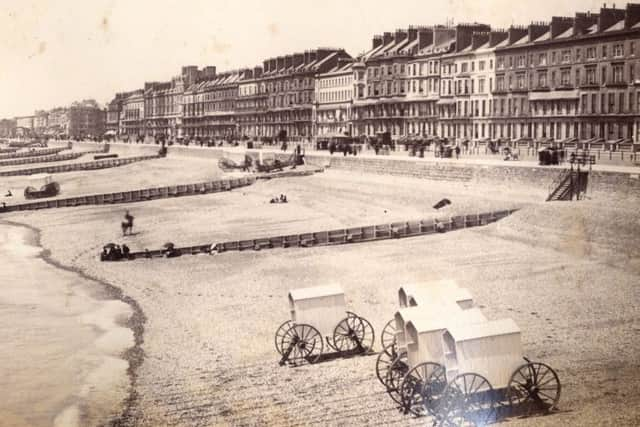

Advertisement
Hide AdAdvertisement
Hide AdA view from Hastings Pier showing Eversfield Place, Warrior Square, St Leonards Arch, the Conqueror Hotel that would be replaced by Marine Court in the 1930’s and South Colonnade, demolished after the last war. Notice the horse, almost in the centre of the picture, he would have been used to move the bathing machines, and notice too the tracks left by the bathing machine wheels and the hoof-prints between them, showing that these machines were far from static. Bottle Alley now provides the barrier between beach and promenade.
2: Eversfield Place from the beach.
This somewhat faded photograph shows a bathing machine being dragged to the sea whilst a young man in bowler hat looks on. Sadly, because of the fading it is not possible to absolutely confirm the image pre-dates Hastings Pier where work had started in 1869.
3: Grand Parade from the beach.
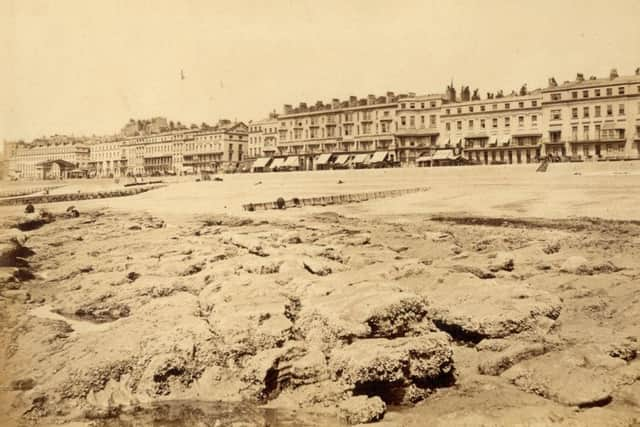

A late 19th century view, pre 1895 because St Leonards Arch is still untouched. Two young men appear to be examining a rock pool. The sea wall would be replaced with Sidney Little’s double-deck promenade with sun-trap shelters in the 1930’s.
4: Hastings Eversfield Place 1877.
The caption reads ‘Hastings Eversfield Place 1877’. 1877 could be the date but more likely the serial number of the picture, although we have no publisher or photographer’s name. The Grand Hotel, originally a terrace of houses forming Verulam Place, is on the right and is now, after demolition and rebuild, Waverley Court.
5: Looking West from Hastings Pier.
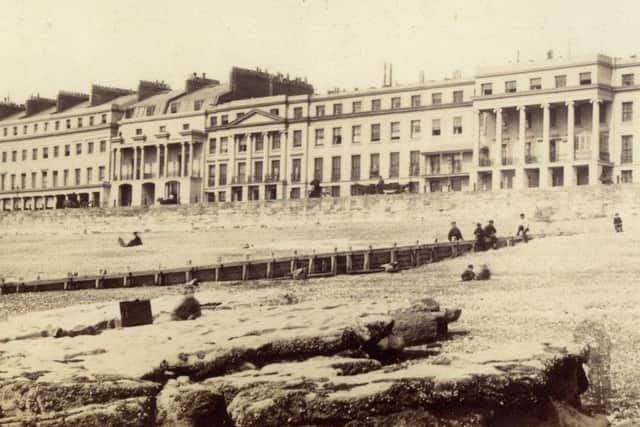

Advertisement
Hide AdAdvertisement
Hide AdAnother fine panorama looking west from Hastings Pier, showing the Grand Hotel on the right, the whole of Eversfield Place, Warrior Square, St Leonards Arch is just visible with South Colonnade at the end of the seafront and bathing machines deployed at various locations along the beach.
6: Marina and St Leonards Arch
Warrior Square is just out of shot on the right. Notice South Saxon Hotel at the bottom of London Road and St Leonards Arch to its left.
7: Marina from the beach.
The terrace with its magnificently colonnaded feature buildings has gone, demolished and replaced with Marine Court in the late 1930’s, but the colonnade on the left remains. Sidney Little’s promenade and Sun Lounge, occupies the area now bounded by the sea wall.
8: St Leonards Arch.
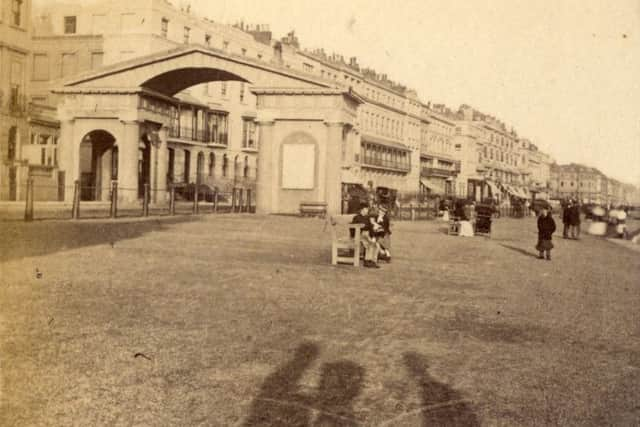

This image from the 1870’s shows iconic St Leonards Arch looking east with the terrace of Grand Parade running past the bottom of London Road on to Warrior Square. We have the shadow of the unnamed photographer and his assistant in the foreground.
9: St Leonards from Hastings Pier
Advertisement
Hide AdAdvertisement
Hide AdThe photographer has used a vantage point at the end of Hastings Pier to produce this panoramic view with the western end of Eversfield Place and tower of St Mary Magdalen Church on the right. In the distance is St Leonards Arch and, only just discernable two, Martello Towers, No 39 where Sea Road joins Grosvenor Gardens and No 40 or 41, further east at Bulverhythe. Had the focus been better, towers 42 and 43, at Bulverhythe might also have been visible. There are clusters of bathing machines and, unusual for St Leonards, washing drying on the beach.
10: St Leonards from the Pier
This is St Leonards from the Pier was taken fairly late in the nineteenth century - St Leonards Pier wasn’t opened to the public until 1891 – and shows the pier balustrading that doubled as seating and the pier pavilion can be seen at the shoreward end. Crown House, built by James Burton and later occupied by Princess Victoria can be seen on the seafront, St Leonards Church, set back from the seafront is visible on the left. It will be destroyed, together with the houses flanking the approach, by a flying bomb in 1944.